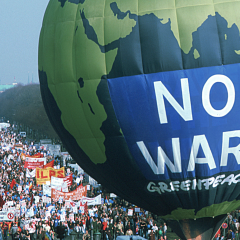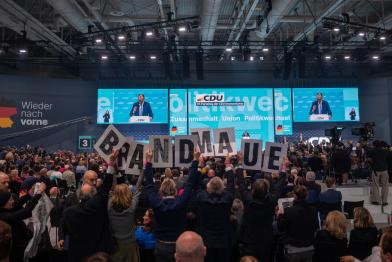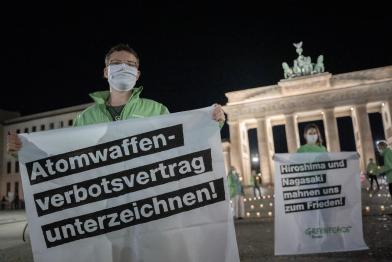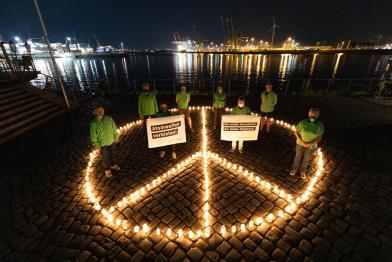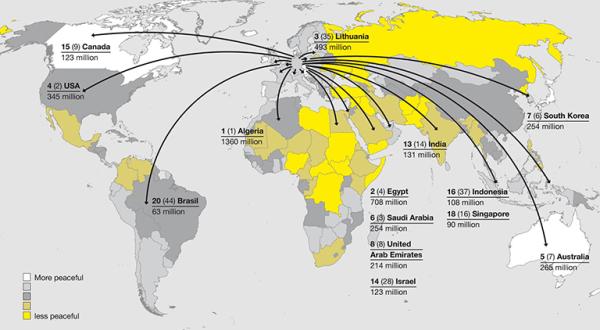
Where do German weapons go?
- Hintergrund
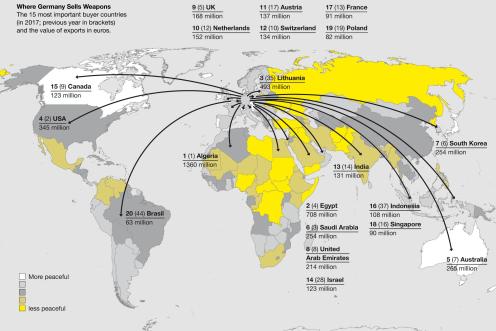
Greenpeace
© Greenpeace
According to the most recent figures from SIPRI, the Stockholm International Peace Research Institute, Germany is the world’s fourth largest weapons exporter – behind the United States, Russia and France, and ahead of countries like China and the UK. This makes Germany a member of a very exclusive club: the five states that together are responsible for seventy-five percent of the global arms trade.
That Germany is one of the world’s largest weapons exporters is not a new development. After its armaments industry was rebuilt following World War II, Germany began exporting weapons on a grand scale in the 1960s. Argentina, Chile, and Greece purchased submarines; Belgium, Italy, and Denmark bought the Leopard 1 combat tank; Pakistan, Turkey, and Iran purchased weapons like the G3 assault rifle and the Cobra anti-tank missile. The 2017 Military Equipment Export Report lists 126 states that were supplied with German military equipment. A total of 11,491 individual export licenses were granted to Germany’s arms industry for this purpose. German war weapons and other military equipment are sold all over the world.
Since Germany began exporting weapons and other military equipment, they have been used in wars and civil wars in buyer countries. Many examples can be found throughout the long decades of Germany’s history of exporting weapons.
- Turkey: Turkish military forces used the Leopard 2 tank during Operation Euphrates Shield in northern Syria in 2016/17. According to official Turkish sources, Euphrates Shield served to combat Islamic State (IS) forces in the region.
- Iran: During the 1960s and 1970s, Iran had extensive access to German weapons technology while it was under the rule of Mohammad Reza Pahlavi, the pro-Western Shah of Iran. The best-known example is the G3 assault rifle; the German government granted Iran licensing to reproduce it and German companies built the production plant in Iran. The G3 became the standard rifle for the Iranian army. During the 1978/79 Iranian Revolution, military forces used it against demonstrators in Tehran, Isfahan, Tabriz, and other cities. After the Shah’s regime collapsed and the Islamic Republic seized power, the G3 was used by the new rulers to suppress a Kurdish uprising. During the Iran-Iraq war from 1980 to 1988, it was the Iranian army’s standard-issue rifle.
- Iraq: Another weapon used during the Iran-Iraq war came from a German-French consortium. Iraq purchased the Roland anti-aircraft system in France, a system which had been jointly developed and manufactured by German and French companies. The German government could have vetoed the Paris sale, but in fact approve it. The system was ultimately used by Iraqi military forces to shoot down several Iranian fighter aircraft. It was also used during the Persian Gulf War in 1990/91, in which an international coalition led by the United States ended Iraq’s occupation of Kuwait, and it was used again during the Iraq War in which the US and allies occupied Iraq. The Roland anti-aircraft system shot down two Tornado fighter jets and an A-10 aircraft.
- Myanmar: During the time when Myanmar was still named Burma but already had a military regime, it acquired production lines from Germany for the G3 assault rifle and munitions. When a movement for democracy rose up against the military dictatorship in 1988, the regime responded with violence. Hundreds of demonstrators died in August when military personnel, armed with the G3, shot into crowds.
- Mexico: Between 2006 and 2009, Mexico bought about 5,000 G36 assault rifles from Heckler & Koch, a weapons company in southwestern Germany. With the company’s knowledge, part of the delivery was transferred by Mexican authorities to four Mexican states which the German government had specifically excluded from delivery at the time it authorized the export. It was later verified that the rifles had been used by Mexican security forces in one of these states, Guerrero, with the suspicion that an extremely serious crime was committed. During a demonstration in Iguala in the fall of 2014, police equipped with G36 rifles arrested 43 students who disappeared without a trace. The assumption is that they were murdered.
- USA: The United States has the world’s most productive arms industry. However, it is also one of the most important customers for Germany’s arms industry, which has and still does supply it with technology and components. The US reproduced Rheinmetall’s 120 mm smoothbore gun to equip its M1 Abrams battle tanks; the US used these tanks in Afghanistan and in the Iraq War from 2003, which began as an invasion violating international law.
- Saudi Arabia: The kingdom is a major customer in the international weapons market. It counts Germany among its suppliers, directly and indirectly. One of the best-known Saudi purchases in Europe have been the Tornado and Eurofighter Typhoon fighter jets, bought in the UK. Both aircraft types are made by European consortiums: the Tornado is a German-Italian-British project, and the Eurofighter is a German-Italian-British-Spanish project. Both aircraft are produced with a share of production carried out in each country in the relevant consortium, regardless of who the customer is, which means that the Tornados and Eurofighters Saudi Arabia bought in the UK have German components. Since 2015, the Saudis have been using both aircraft types in the war in Yemen. Bomb raids have already killed a countless number of civilians there.
German weapons and other military equipment are used in wars that violate international law, for the suppression of the population, and even against German allies. The German government did not intend them for these purposes. But such use is ultimately accepted because it is clear that once military equipment has been delivered, it can no longer be monitored. It is impossible to say what a purchasing government will do with it. It cannot even be said whether a buyer government will still be in power a few years after the purchase, as in the example of Iran.
On paper, Germany has particularly restrictive guidelines for arms exports, and the German government repeatedly makes this point. So what’s the explanation for Germany always being among the biggest weapons exporters in the world — currently in fourth place? In fact, these guidelines may be more restrictive than the UK’s or France’s, but they are not restrictive as such. They allow every Germany government plenty of leeway to supply arms to dictatorships, nations at war and countries experiencing internal tensions, and to deliver weapons to crisis zones.
That’s why German weapons are used against demonstrators, repressed minorities, and states — by allied nations like Iran, by democracies like Mexico, by dictatorships like Argentina’s in the past, by business partners like Saudi Arabia, and by allies like the United States. This is unacceptable.
Greenpeace demands a radical about-face in Germany’s policy on exporting military equipment:
- No exports to dictatorships.
- No exports to third countries.
- No exports to war and crisis zones.
- No government subsidies for arms exports.
- A complete ban on the export of small arms and light weapons.
